Reptiles
Children’s Python
SCIENTIFIC NAME: Antaresia childreni
Found in Australia and neighboring islands, the Children’s Python is named for John George Children, a zoological curator at the British Museum and mentor of John Edward Grey, who published the original description of the species in 1842.
Like other pythons, the Children’s is a non-venomous constrictor, with a diet consisting mostly of smaller reptiles, birds, and mammals.
Fun facts: This specimen is known to inhabit cave systems, hanging from stalactites, and feeding upon microbats.
Leopard Tortoise
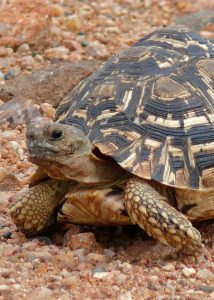 COMMON NAME: Leopard Tortoise
COMMON NAME: Leopard Tortoise
SCIENTIFIC NAME: Stigmochelys pardalis
This Tortoise is named for their yellow and black, cylindrically patterned shell, which resembles the pattern of Leopard spots. Found amongst the savannah grassland of Sub-Saharan Africa, the Leopard Tortoise is considered the fourth largest Tortoise in the world behind the Galapagos, Aldabra Giant, and African Spurred Tortoises.
They feed on a range of vegetation, including grasses, succulents, prickly pear, thistle, and watermelon.
Female Leopard Tortoises may lay up to thirty eggs in a single nest, and their eggs may incubate from five months, to over a year before hatching, depending on seasonal conditions.
Fun Fact: Leopard Tortoises are capable of living for over 100 years.
Red-footed Tortoise
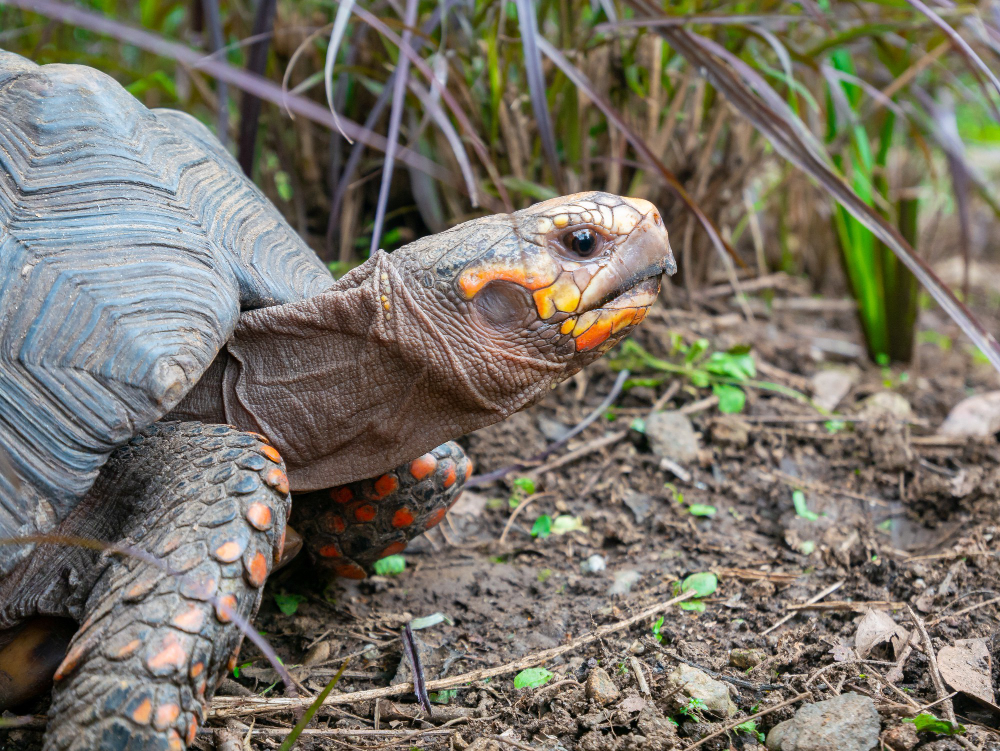 COMMON NAME: Red-footed Tortoise
COMMON NAME: Red-footed Tortoise
SCIENTIFIC NAME: Chelonoidis carbonaria
Red-Footed Tortoises are native to South America and the Caribbean islands of Trinidad and Barbados. Their name is derived from the red spots along their front legs.
These Tortoises can be found in habitats such as grasslands, forests, and the edges of tropical rainforests. They feed on fruits, flowers, fungi, invertebrates and even carrion. In eating native fruits, they serve an important ecological function by dispersing seeds via their dung.
They are largely docile and not territorial, until the breeding season. Males will engage in battle for breeding rights, beginning with jerking heads gestures, before attempting to flip one another over on their backs.
Females dig a nest amongst the forest floor and will lay a clutch of up to 15 eggs. Hatchlings which survive to adulthood may live for up to 50 years.
Fun Fact: During courtship, the male will make a distinct sound, similar to the clucking of a hen.
Sulcata Tortoise
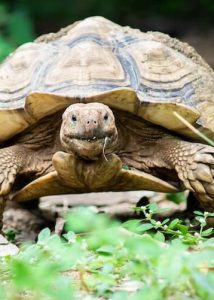 COMMON NAME: Sulcata Tortoise
COMMON NAME: Sulcata Tortoise
SCIENTIFIC NAME: Centrochelys sulcata
TYPE: Reptile
DIET: Herbivore
GROUP NAME: Creep
LIFESPAN: 80 - 100 yrs
SIZE: 24 - 36 in
WEIGHT: 70 - 150 pounds, some males – 200 pounds
STATUS: Vulnerable
THREATS: Habitat Loss, Hunting, and Illegal Pet Trade.
FUN FACT: Shell has growth rings that indicate the tortoises age
Three-Toed Box Turtle
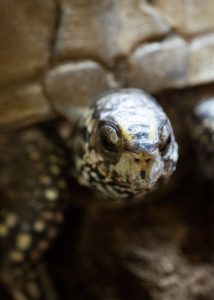 COMMON NAME: Three-Toed Box Turtle
COMMON NAME: Three-Toed Box Turtle
SCIENTIFIC NAME: Terrapene Carolina triunguis
This species is native to the Central and Southern United States. While they may resemble a tortoise, with their bulbous shell, they are actually a land-dwelling turtle.
Their name is derived from the three toes on their rear feet and their ability to close themselves up like a box. The bottom of their shell, or ‘Plastron’ has a hinge-like structure in the middle, which allows the turtle to close the front and rear openings of their shell when threatened.
They are omnivores with a diet including plant matter, invertebrates, frogs, snakes, and even small mammals.
Fun Fact: The Three Toed Box Turtle is the official State Reptile of Missouri.
Ornate Box Turtle
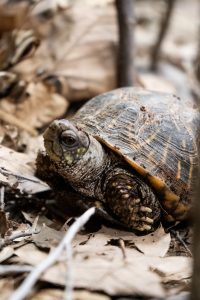 COMMON NAME: Ornate Box Turtle
COMMON NAME: Ornate Box Turtle
SCIENTIFIC NAME: Terrapene ornata ornata
The Ornate Box Turtle is named for their intricately lined shell. Box turtles are also identified by the hinge-like structures on the bottom portion of their shell, also known as the plastron, which allow the Turtle to enclose themselves within their shell.
This species in found across the Midwest region of the United States, and toward the Gulf of Mexico. Though their numbers are decreasing in some areas due to habitat loss and climate change.
They are land-dwelling turtles, and while they do not spend time under water, they do require a nearby water source, and will burrow underground to preserve moisture.
They are omnivorous. Their diet is varied and includes invertebrates, berries, fungi, small fish reptiles, amphibians, and eggs.
Fun Fact: They are small in stature and rarely exceed six inches in length.
Painted Turtle
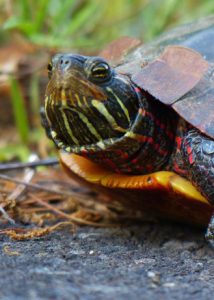 COMMON NAME: Painted Turtle
COMMON NAME: Painted Turtle
SCIENTIFIC NAME: Chrysemys picta
Painted Turtles are the most common turtle in North America. They can also be found in Southern Canada and Northern Mexico.
They feed on aquatic insects, small fish, crustaceans, and snails, as well as carrion algae, and vegetation, such as cattails. They must feed while submerged under water, as their tongues do not have full range of motion, creating an inability to swallow.
Fun Fact: Under the right conditions, this species is thought to be able to withstand freezing temperatures due to a liver protein, which prevents ice crystals forming within bodily fluids from becoming larger and damaging the body from within.
Black Rat Snake
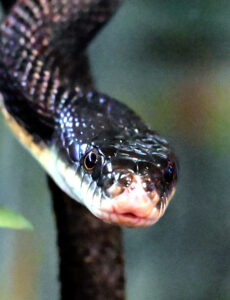 COMMON NAME: Black Rat Snake
COMMON NAME: Black Rat Snake
SCIENTIFIC NAME: Pantherophis obsoletus
TYPE: Reptile
DIET: Mice, other small rodents, bird eggs, and small lizards
GROUP NAME: Den (though usually solitary)
LIFESPAN: 10–15 years in the wild
SIZE: 3.5–6 feet in length
WEIGHT: 1–2.5 lbs (not shown in your version, optional)
STATUS: Least Concern
HABITAT: Most commonly found in wooded areas, often near water
BEHAVIOR: Excellent climbers and swimmers. Known for buzzing their tails when frightened to mimic a rattlesnake
FUN FACT: Despite their intimidating appearance, black rat snakes are non-venomous and beneficial pest controllers in their ecosystems.
Red-Tailed Boa Constrictor
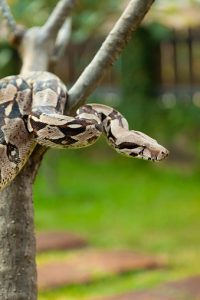
COMMON NAME: Red-Tailed Boa Constrictor
SCIENTIFIC NAME: Boa constrictor constrictor
TYPE: Reptile
Native to South America, the Red-Tailed Boa is named for the red hued blotches toward the end of their tail. Coloration and pattern are important to this snake. Their dark marking and lighter base color provide camouflage which is vital to this ambush predator.
Like all Boas, this snake is a constrictor, lacking venom. When a prey animal, such as a rodent, bird or lizard comes near, they will strike, coil their body around it, and squeeze, suffocating the animal. They do not possess heat-sensing pits like many other snakes. Instead, they flick their tongue, and a vomeronasal organ in the roof of their mouth transmits signals directly to the brain.
They are considered one of the smaller species of Boa Constrictor, with an average length of six to eight feet and weight of up to 50 pounds.
Fun Fact: The Red-Tailed Boa is ovoviviparous, meaning that young emerge from their eggs, within the female, before being born. A female may give birth to over 30 young at a time.
Blue Tongue Skink
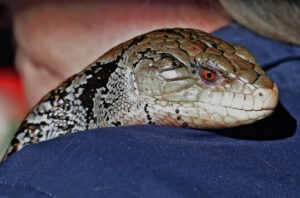 COMMON NAME: Blue-Tongue Skink
COMMON NAME: Blue-Tongue Skink
SCIENTIFIC NAME: Tiliqua spp. (most commonly Tiliqua scincoides)
TYPE: Reptile
DIET: Omnivore (fruits, vegetables, insects, snails, eggs, and small animals)
GROUP NAME: Lounge (not commonly used—these lizards are solitary)
LIFESPAN: 15–20 years in captivity
SIZE: 17–24 inches (43–61 cm)
WEIGHT: 1–2.5 lbs (450–1130 g)
STATUS: Least Concern
THREATS: Habitat loss, pet trade, predation by cats, dogs, and birds of prey
FUN FACT: Blue-tongue skinks flash their bright blue tongue as a defense mechanism to scare off predators—it makes them look toxic even though they're harmless!
Yellow Spotted (Amazon) River Turtle
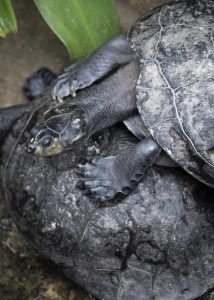 COMMON NAME: Yellow Spotted (Amazon) River Turtle
COMMON NAME: Yellow Spotted (Amazon) River Turtle
SCIENTIFIC NAME: Podochemis unifillis
Found in the Amazon and Orinoco River systems of South America, this turtle is named for the bright yellow spots adorning the heads of juveniles and males.
They are omnivores and will eat a variety of foods including fruits, vegetation, small fish and invertebrates.
A male will initiate courtship by nipping at the feet and tail of a female. Females will lay a clutch of eggs in a shallow nest along the riverbank during the dry season. Eggs which develop at temperatures above 89 degrees Fahrenheit will be female. Those maturing at temperatures below 89 degrees, will be male.
This species is largely threatened by habitat loss.
Fun fact: These turtles are also known as Yellow-Headed Side-Necked Turtles. They have a long neck which, unlike many other turtles, they cannot retract inside their shell. Instead, they tuck their head and neck to the side, under the curve of their shell for protection.
Speckled Kingsnake
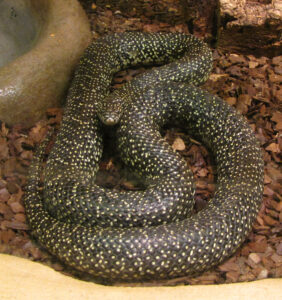
Holbrookin kuningaskäärme.
COMMON NAME: Speckled Kingsnake
SCIENTIFIC NAME: Lampropeltis holbrooki
TYPE: Reptile
DIET: Carnivore – eats mice, rats, lizards, birds, eggs, and other snakes (including venomous ones)
GROUP NAME: Knot or den (though typically solitary)
LIFESPAN: 15–20 years in captivity; around 10–15 years in the wild
SIZE: 3–5 feet (91–152 cm) in length
WEIGHT: 1.5–3 lbs (0.7–1.4 kg)
STATUS: Least Concern
HABITAT: Grasslands, woodlands, marsh edges, and farmland across the central and southern United States
BEHAVIOR: Non-venomous constrictor that subdues prey by coiling. Known for mimicking rattlesnakes by vibrating its tail when threatened.
FUN FACT: Speckled kingsnakes are called "salt-and-pepper snakes" because of their dark scales covered with light-colored speckles. They are immune to the venom of pit vipers, making them effective predators of copperheads and rattlesnakes!
Western Hinge-Back Tortoise
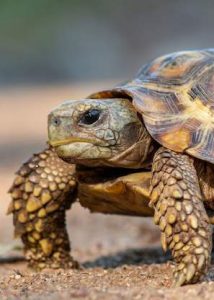 COMMON NAME: Western Hinge-Back Tortoise
COMMON NAME: Western Hinge-Back Tortoise
SCIENTIFIC NAME: Kinixys belliana nogueyi
This Western Hingeback Tortoise is native to Sub Saharan Africa and can be found from Senegal to Cameroon and the Central African Republic.
Their name is derived from the hinge-like structures toward the rear of their shell. These hinges allow the top of their shell, or ‘Carapace,’ to shut down on the bottom half of their shell, called the ‘Plastron,’ protecting the tortoise when threatened from behind.
The carapace is also elongated at the front. This allows the tortoise to retract their front legs as well as their head.
Fun Fact: Unlike many other tortoises which are known to prefer leafy greens and grasses the Western Hingeback has a diet largely consisting of invertebrates, supplemented with fruits and fungi.
Speckled Kingsnake

COMMON NAME: Corn Snake
SCIENTIFIC NAME: Pantherophis guttatus
TYPE: Reptile
DIET: Mice, rats, birds, bats, and bird eggs
GROUP NAME: Den (typically solitary in the wild)
LIFESPAN: Up to 20 years in captivity; 6–8 years in the wild
SIZE: 3–6 feet (91–183 cm) in length
WEIGHT: 1.5–2.5 lbs (adults)
STATUS: Least Concern
HABITAT: Forest openings, overgrown fields, rocky hillsides, barns, and abandoned buildings—especially near grain stores that attract rodents
BEHAVIOR: Non-venomous constrictors; they are excellent climbers and are primarily active at dawn and dusk. Often freeze or rattle tails when threatened to mimic venomous snakes.
FUN FACT: Corn snakes get their name from the checkerboard pattern on their bellies, which resembles maize (corn) kernels—not because they eat corn!
Photo by Glenn Bartolotti, CC BY-SA 4.0



